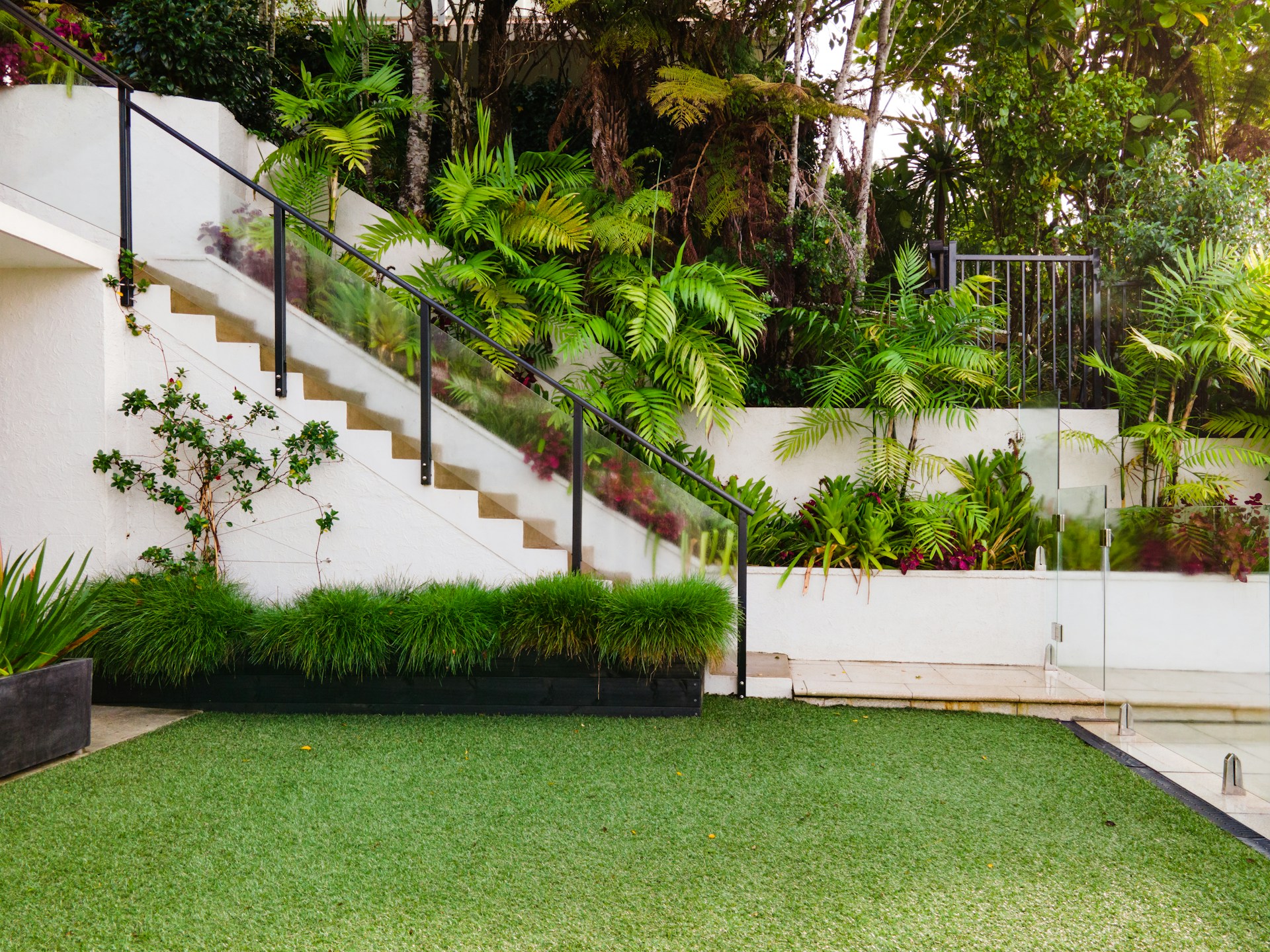PROPERTYSPARK ARTICLE
Real Estate Vs High-Yield Savings Accounts – Which Is Best For 2024?
Much like finding the perfect Cinderella slipper, choosing the right concrete sleepers for your landscaping project can be a daunting task. You’re about to embark on an important journey that will significantly transform your outdoor space.
With a myriad of options available, it’s essential to know which type of concrete sleeper suits your project best. From understanding the basics of concrete sleepers, through to the importance of these in landscaping, types of sleepers, and key factors to consider when choosing them, this guide will shine a light on the path.
But that’s not all, we’ll also discuss how to install them effectively and maintain their longevity. Your well-dressed garden awaits.

Understanding Concrete Sleepers
To fully appreciate the benefits of concrete sleepers for landscaping, you need to understand what they are and how they function.
Essentially, concrete sleepers in Adelaide are sturdy, long-lasting blocks used to create solid, reliable structures. They are often used in railway systems, but have been finding a place in landscaping due to their durability and aesthetic appeal.
You might wonder how they work. Well, it’s pretty straightforward. When you’re building a retaining wall or similar structure, you’ll lay these sleepers out, one on top of the other, using them as building blocks. They are designed to interlock, creating a solid, stable structure that won’t easily topple or crumble, even under heavy pressure.
Now, you’re probably thinking, ‘Why would I use these over traditional wooden sleepers?’ It’s simple – they’re built to last. Concrete doesn’t rot, warp, or get eaten by pests. So, while you might need to replace wooden sleepers every few years, concrete ones can last a lifetime. It’s a long-term investment that could save you time and money in the long run.
In short, understanding concrete sleepers is the first step to enhancing your landscape’s durability and charm.
Importance of Concrete Sleepers in Landscaping
When it comes to landscaping, the significance of concrete sleepers can’t be overstated. These sturdy, versatile structures are vital in creating elegant and durable outdoor spaces. You’ll find them invaluable in constructing retaining walls, garden beds, or steps.
Their primary role is providing structural support, especially on sloping terrains. They help control soil erosion, manage water flow, and add stability to your landscape. If you’re dealing with uneven ground, concrete sleepers can be a godsend. They’ll allow you to create leveled areas for outdoor activities and plant growth.
Concrete sleepers also offer incredible longevity. Unlike wood or metal, they’re resistant to termites, rust, and decay. That means you’ll spend less time worrying about maintenance and more time enjoying your outdoor space.
Aesthetically, concrete sleepers give you lots of design flexibility. They come in various textures, colors, and patterns, letting you match your landscape’s look and feel. So, whether you’re going for a rustic or modern vibe, concrete sleepers can help you achieve it.
Clearly, concrete sleepers are more than just functional; they’re an essential element in creating a beautiful, long-lasting landscape. Don’t underestimate their importance in your next landscaping project.
Types of Concrete Sleepers
You’ll find a variety of concrete sleepers on the market, each designed with specific features to suit different landscaping needs. Let’s delve into the main types, so you can make an informed decision.
First off, we’ve the plain concrete sleepers. They’re the most basic type, but don’t let that fool you. They’re sturdy, durable and a perfect fit for a minimalist aesthetic.
Next up are the reinforced concrete sleepers. They’re infused with steel bars or mesh, enhancing their strength. If you’re dealing with heavy loads or tough weather conditions, these might be your best bet.
Decorative concrete sleepers are your third option. They come in a wide array of designs, colors, and textures. If you’re looking to add a visual pop to your landscape, these are for you.
Finally, the pre-stressed concrete sleepers. They’re made by applying tension to the reinforcing bars before the concrete hardens. These sleepers offer high load-bearing capacity and exceptional durability.
Each type has its strengths and its ideal uses. By understanding these, you’ll be able to select the right concrete sleepers for your landscaping project.
Factors to Consider When Choosing Sleepers
Picking the right concrete sleepers for your landscape project isn’t just about aesthetics; it’s crucial to consider factors like durability, cost, and maintenance needs. You don’t want to invest in sleepers that won’t last, cost too much, or require excessive upkeep.
Let’s delve into these factors more thoroughly:
-
Durability:: Concrete sleepers are designed to withstand the elements, but not all are created equal.
- How well do they resist weathering and erosion?
- Can they stand up to heavy loads?
Consider these points:
-
Cost:: Remember, the cheapest option isn’t always the best.
- Is the initial investment worth the lifespan of the sleepers?
- Are there hidden costs, like installation or maintenance?
Weigh these aspects:
-
Maintenance:: No one wants a high-maintenance landscape.
- How often will you need to clean or repair the sleepers?
- Are special tools or skills required?
Think about:
Carefully considering these factors will ensure your concrete sleepers are a smart, cost-effective, and lasting addition to your landscape project. So, think wisely before you make your choice.
Installation Tips for Concrete Sleepers
Installing concrete sleepers correctly is crucial for ensuring their longevity and effectiveness in your landscape project. Start by preparing the ground where they’ll be placed. It needs to be level and firm. You can use a compacting machine to pack down the soil, ensuring it’s stable and ready for the sleepers.
Next, arrange your sleepers in the desired pattern. Remember, you’re aiming for a snug fit. Don’t forget to leave room for drainage – this stops water from pooling and potentially damaging your sleepers.
When it’s time to lay your sleepers, use a spirit level to check they’re straight. You should also use a rubber mallet to tap them into place. This reduces the risk of any damage during installation.
Finally, remember to backfill behind your sleepers. This supports them and reduces the risk of shifting or falling over time. You can use a mix of soil and gravel for this, ensuring good drainage.
Don’t rush this process. Take your time to get it right, and you’ll have a landscape feature that lasts for years. And remember, if you’re not confident, it’s always worth hiring a professional.
Maintaining Your Concrete Sleepers
Once installed, keeping your concrete sleepers in top shape isn’t as daunting as it may seem. With a little effort and the right approach, you can prolong their lifespan and preserve their visual appeal.
Here’s a simple maintenance guide to help you out:
-
Regular Cleaning
- Dirt, leaves, and other debris can cause staining and eventual damage. Regularly sweep or hose down your concrete sleepers to keep them clean.
- For stubborn stains, a mild detergent and a soft brush can work wonders. Avoid using harsh chemicals as they can damage the concrete.
-
Sealant Application
- Concrete is porous and can absorb water, leading to cracks over time. Applying a concrete sealer can help protect your sleepers from moisture and weather elements.
- Before applying the sealer, ensure your sleepers are clean and dry. You’ll need to reapply the sealer every few years to keep your sleepers protected.
Frequently Asked Questions
What Is the Average Cost of Concrete Sleepers?
You’re asking about the average cost of concrete sleepers. It’s tricky, as it varies based on size and quality. Generally, you’re looking at anywhere from $20 to $60 per sleeper. Always factor in delivery and installation costs.
Can I Install Concrete Sleepers Myself or Should I Hire a Professional?
You can install concrete sleepers yourself if you’re handy and have proper tools. However, hiring a professional ensures correct installation and can save potential costly mistakes. Consider your skill level and time availability.
What Are the Common Issues or Problems That Can Arise With Concrete Sleepers?
Like navigating a ship through stormy seas, you may encounter issues with concrete sleepers. They can crack, discolor, or warp over time. Drainage problems could arise and incorrect installation might lead to structural instability.
How Does the Weight of Concrete Sleepers Compare to Other Materials?
Concrete sleepers are generally heavier than other materials. You’ll find they weigh more than wood or plastic options, but this added weight can provide stability and durability that lighter materials might not offer.
Are There Any Environmentally Friendly Alternatives to Concrete Sleepers?
Yes, there are environmentally friendly alternatives to concrete sleepers. You could consider using recycled plastic or composite sleepers. They’re not only eco-friendly but also durable, lightweight, and require less maintenance than traditional materials.
Conclusion
In the end, picking the right concrete sleepers for your landscape is no walk in the park. But, armed with this guide, you’re set to make an informed choice.
Remember, the right sleeper isn’t just about looks, but also durability and ease of installation. With proper care, they’ll stand as steadfast guardians of your garden, weathering storms and sunshine alike.
So, dive in and let your landscaping project bloom under the silent watch of your concrete sleepers.
Learn how to Become a Top Agent with the Guaranteed 5 Min/Week System
No social media experience needed
Free webinar seat (limited quantities)
Learn the guaranteed 5 min/week system
Become a social media superstar
Constantly get new leads
Beat the competition
Get a special webinar deal
This Agent Tripled His Commissions Just With Social Media
Learn how this real estate agent tripled his commissions just with social media and how you too can become a social media superstar.
Why You Can’t Just “Boost” Your Real Estate Listing
That big blue button has tempted you before right? You want to Facebook Boost your Real Estate listing. Find out why you shouldn’t!
How Much Should Realtors Spend On Social Media
A question we get often from Realtors is “how much should I spend on social media?” Find out exactly how much to spend and how to spend it without getting ripped off!


